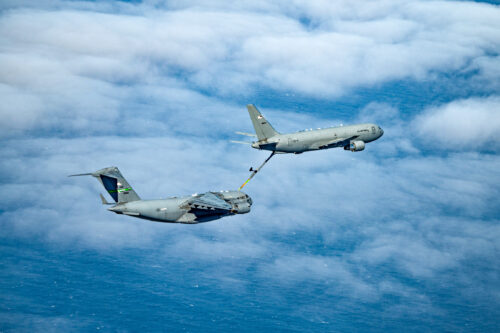The 7th Expeditionary Airlift Squadron (EAS) recently concluded its participation in Exercise Bamboo Eagle 25-1. This exercise, a crucial certification event ahead of the squadron’s upcoming deployment, has not only validated but also refined the 7th EAS’s tactical capabilities in dynamic and contested environments.

A standout achievement by the unit during Bamboo Eagle 25-1 was the first-ever low-altitude aerial refueling conducted by the 7th EAS with a KC-46 Pegasus. According to Capt. Ryan Corvin, a 7th EAS pilot, this operation provided “a great experience and great to see yet another capability of the C-17 and the Air Force,” further stating that conducting refueling at lower altitudes provided “a big confidence boost to see how low it can actually be done if ever required in a real-world conflict”.
Moreover, the 7th EAS executed integrated combat turns (ICT), facilitating the rapid refueling and rearming of F-35 aircraft, before redeploying them back into simulated combat operations. This capability is crucial for enhancing operational readiness and ensuring sustainment by significantly reducing turnaround times. Capt. Marcus Malecek, 7th EAS weapons officer, emphasized the strategic importance of these advancements, stating, “The next fight will be won by decisive and annihilating maneuver, the 7th EAS is that maneuver”.
In addition to aerial refueling and integrated combat turns, the 7th EAS demonstrated its proficiency in semi-prepared runway operations, executing landings and takeoffs on austere airstrips. Such training is invaluable for simulating real-world deployment scenarios, bolstering the squadron’s ability to deliver combat airlift in areas with limited infrastructure. Capt. Elizabeth Roudbari, a 7th EAS pilot, shared her experience of landing on dirt for the first time, noting that “the C-17 has the capability to land on semi-prepared surfaces, and being able to do that in a training environment built the confidence to be able to do it in the real world if the time came”.
Dynamic retasking emerged as a key theme throughout Exercise Bamboo Eagle 25-1, with aircrews adapting to real-time mission changes that demanded close coordination with maintenance and support teams. Capt. Ryan Stein, a 7th EAS pilot, highlighted the lessons learned, stating, “My biggest lesson learned from BE 25-1 was what dynamic retasking will truly look like as we go into the next fight…On this exercise, we added stops and tactical events, which required different preparation and assistance from our maintenance and support teams in real time on condensed timelines”.
Throughout the exercise, the 7th EAS flew over 80 sorties, accumulating nearly 150 flying hours, while transporting over 690,000 pounds of equipment and more than 550 personnel across various locations. The exercise also encompassed 11 semi-prepared runway landings, nine night-vision goggle assault landings, and five high-pressure altitude airfield landings. Furthermore, the 7th EAS played a pivotal role in supporting the U.S. Air Force Warfare Center exercise observation tour, transporting Maj. Gen. Christopher Niemi and his team to March Air Reserve Base, California. The squadron also facilitated disaggregated operations, strategically moving personnel and equipment to San Clemente Island to support expeditionary training objectives. Additionally, the 7th EAS conducted eight specialized fueling operations and completed six pilot check rides, ensuring sustained readiness for high-end mobility missions.
The success of the 7th EAS during Exercise Bamboo Eagle 25-1 also hinged on crew cohesion and adaptability. Roudbari noted that “the biggest lesson learned is that crew complement matters…we had some long days with some challenging obstacles, and every crew I was a part of approached the problems with mutual respect and humility”.
In conclusion, Exercise Bamboo Eagle 25-1 has proven to be an invaluable training opportunity for the 7th EAS, refining air mobility tactics and enhancing overall mission effectiveness. The experience gained during this exercise ensures that aircrews are well-prepared to tackle the multifaceted challenges of future conflicts, reinforcing their critical role in delivering combat airlift capabilities, anytime, anywhere.
For more information, hit the Source below